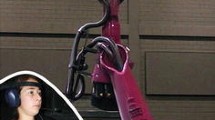Summary
The basic characteristics of the sensation of linear horizontal motion have been studied. Objective linear motion was induced by means of a moving cart. Visually induced linear motion perception (linearvection) was obtained by projection of moving images at the periphery of the visual field. Image velocity and luminance thresholds for the appearance of linearvection have been measured and are in the range of those for image motion detection (without sensation of self motion) by the visual system. Latencies of onset are around 1 sec and short term adaptation has been shown. The dynamic range of the visual analyser as judged by frequency analysis is lower than for the vestibular analyser. Conflicting situations in which visual cues contradict vestibular and other proprioceptive cues show, in the case of linearvection a dominance of vision which supports the idea of an essential although not independent role of vision in self motion perception.
Similar content being viewed by others
References
Berthoz, A., Pavard, B., Young, L.R.: Rôle de la vision périphérique et interactions visuo-vestibulaires dans la perception exocentrique du mouvement linéaire chez l'homme. C.R. Acad. Sci. (Paris) 278, D, 1605–1608 (1974)
Brandt, Th., Wist, E., Dichgans, J.: Optisch induzierte Pseudo Coriolis-Effecte und Circularvektion. Arch. Psychiat. Nervenkr. 214, 365–389 (1971)
Brandt, Th., Dichgans, J., Koenig, B.: Perception of self-rotation induced by optokinetic stimuli. Pflügers Arch. 332, R98 (1972)
Brandt, Th., Dichgans, J., Koenig, E.: Differential effects of central and peripheral vision for egocentric and exocentric motion perception. Exp. Brain Res. 16, 476–491 (1973)
Clark, B.: The oculogravic illusion as a test of otolith function. In: Third Symp. on the role of the vestibular organs in the exploration of space. NASA SP 152, 331–339 (1968)
Clark, B., Graybiel, A.: Apparent rotation of a fixed target associated with linear acceleration in flight. Amer. J. Ophthal. 32, 549–557 (1949)
Daniel, K.: Der Einfluß der Reizmarkengröße auf die Lichtunterschiedsempfindlichkeit der Netzhaut bei verschiedenen Adaptationszuständen. Inaugural dissertation. Tübingen. (1959). In: Handbook of sensory physiology: visual psychophysics, p. 126–127. (ed Jameson, D., Hurvich, L.M.). Berlin-Heidelberg-New York: Springer 1972
Denton, G.C.: The influence of visual pattern on perceived speed, p. 409–420. Crowthorne, G.B.L.R.: Road Research Laboratory Report 1971
Dichgans, J., Brandt, Th.: The psychophysics of visually induced perception of self-motion and tilt. In: The Neurosciences III, p. 123–129. MIT Press 1974
Dichgans, J., Held, R., Young, L., Brandt, Th.: Moving visual scenes influence the apparent direction of gravity. Science 178, 1217–1219 (1972)
Dichgans, J., Schmidt, C.L., Graf, W.: Visual input improves the speedometer function of the vestibular nuclei of the goldfish. Exp. Brain Res. 18, 319–322 (1973)
Fischer, M.H., Kornmüller, A.E.: Optokinetisch ausgelöste Bewegungswahrnehmungen und optokinetischer Nystagmus. J. Pscyhol. Neurol. (Lpz.) 41, 383–420 (1930)
Gibson, J.: The visual perception of objective motion and subjective movement. Psychol. Rev. 61, 304–314 (1954)
Graybiel, A.: Oculogravic Illusion. Arch. Ophthal. 48, 605–615 (1952)
Henn, V., Young, R.L., Finley, C.: Vestibular units in alert monkeys are also influenced by moving visual fields. Brain Res. 71, 144–149 (1974)
Jongkees, L.B.W.: On the otoliths: their function and the way to test them. In: Third Symposium on the role of vestibular organs in space exploration. 1967. NASA SP 152, 307–331 (1968)
Lee, D.N., Aronson, E.: Visual proprioceptive control of standing in human infants. Perception and psychophysics 15, 529–532 (1974)
Lishman, J.R., Lee, D.N.: The autonomy of visual kinaesthesis. Perception 2, 287–294 (1973)
Lipetz, L.E.: The Creation of physiological and psychological aspects of sensory intensity. In: Handbook of Sensory Physiology, Vol. I, p. 191–225. (ed. Loewenstein, W.). BerlinHeidelberg-New York: Springer1971
Mach, E.: Grundlinien der Lehre von den Bewegungsempfindungen, 129 pp. Leipzig: Engelann 1875
Maekawa, A., Simpson, J.: Climbing fiber activation of Purkinge cells in the flocculus by impulses transferred through the visual pathways. Brain Res. 39, 245–251 (1972)
Salvatore, S.: Velocity sensing. Highway Res. Record 282, 79–90 (1968)
Schmidt, F., Tiffin, J.: Distortion of drivers' estimates of automobile speed as a function of speed adaptation. J. appl. Psychol. 53, 536–539 (1969)
Schöne, H., Mortag, H.G.: Variation of the subjective vertical on the parallel swing at different body positions. Psychol. Forsch. 32, 124–134 (1968)
Sharpe, C.R., Tolhurst, D.J.: Orientation and spatial frequency channels in peripheral vision. Vision Res. 13, 2103–2112 (1973)
Udo de Haes, H.A., Schöne, H.: The effectiveness of the statolith organs in human spatial orientation. Acta oto-laryng. (Stockh.) 69, 25–31 (1970)
Young, L.R.: On visual-vestibular interaction. In: 5th Symposium: The role of the vestibular organs in space exploration (Pensacola). NASA SP 314, 205–210 (1970)
Young, L.R., Meiry, J.L.: A revised dynamic otolith model. Aerospace Med. 39, 606 (1965)
Young, L.R., Dichgans, J., Murphy, R., Brandt, Th.: Interaction of optokinetic and vestibular stimuli in motion perception. Acta oto-laryng. (Stockh.) 76, 24–31 (1973)
Young, L.R., Henn, V.S.: Selective habituation of vestibular nystagmus by visual stimulation. Acta oto-laryng. (Stockh.) 77, 159–166 (1974)
Young, L.R., Oman, C.: Influence of head position and field on visually induced motion effects in three axes of rotation. In: Proc. of 10th Annual Conference in Manual Control Wright Patterson AFB, (Ohio) (1974)
Young, L.R., Oman, C., Dichgans, J.: Influence of head orientation on visually induced pitch and roll sensation. Aviation and Environmental Medecine 46, 264–268 (1975)
Author information
Authors and Affiliations
Additional information
Preliminary reports of this work have been presented in the form of a short communication (Berthoz et al., 1974) and at the European Brain and Behaviour Society Workshop on: “Vestibular function and behaviour” (Pavia, Brain Research, Special issue, p. 17, 1974).
Rights and permissions
About this article
Cite this article
Berthoz, A., Pavard, B. & Young, L.R. Perception of linear horizontal self-motion induced by peripheral vision (linearvection) basic characteristics and visual-vestibular interactions. Exp Brain Res 23, 471–489 (1975). https://doi.org/10.1007/BF00234916
Received:
Issue Date:
DOI: https://doi.org/10.1007/BF00234916




